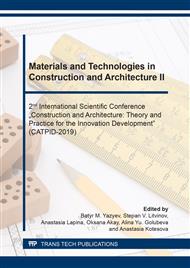[1]
P.M. Zhuk, A.D. Zhukov, The regulatory legal framework for the environmental assessment of building materials: the prospects for improvement. Ecol. and Ind. of Russia. 4 (2018) 52-57.
Google Scholar
[2]
N.A. Ivanova, The main directions of the prospects for the development of housing at the local level. Moscow Econ. J. 4 (2018) 65-74.
Google Scholar
[3]
N.P. Umnyakova, V.M. Tsygankov, V.A. Kuzmin, Experimental heat engineering studies for rational design of wall structures with reflective heat insulation. Zhil. Stroy. 1-2 (2018) 38-42.
Google Scholar
[4]
V.S. Semenov, T.A. Rozovskaya, A.Yu. Gubsky, Prospects for the use of recycled polyester fibers for the production of heat and sound insulating materials. Build. Mat. 6 (2016) 21-24.
Google Scholar
[5]
A.D. Zhukov, K.A. Ter-Zakaryan, I.V. Bessonov, V.S. Semenov, A.V. Starostin, Insulation systems for frame cottages. Academia 1 (2019) 122–127.
DOI: 10.22337/2077-9038-2019-1-122-127
Google Scholar
[6]
R.S. Fedyuk, A.V. Mochalov, V.A. Simonov, Trends in the development of standards for the thermal protection of buildings in Russia // Bull. of the School of Eng. FEFU. 2 (2012) 39–44.
Google Scholar
[7]
I. Gimenez, M.-K. Faroog, A. El Mahi, A. Kondrotas, M. Assarar, Experimental analysis of mechanical behavior and damage development mechanisms of PVC foams in static tests. Mat. Sci. (Medžiagotyra). 10 (2004) 34–39.
Google Scholar
[8]
A.D. Zhukov, K.A. Ter-Zakaryan, V.S. Semenov, Insulation systems with the expanded polyethylene application. ScienceDirect IFAC Vol 51 30 (2018) 803-807.
DOI: 10.1016/j.ifacol.2018.11.191
Google Scholar
[9]
I.J. Gnip, V.J. Keršulis, S.J. Vaitkus, Analytical description of the creep of expanded polystyrene under compressive loading. Mech. of Comp. Mat. 41 (2005) 357–364.
DOI: 10.1007/s11029-005-0061-5
Google Scholar
[10]
A.D. Zhukov, V.S. Semyonov, I.J. Gnip, S.J. Vaitkus, The investigation of expanded polystyrene creep behavior. MATEC Web of Conf. 117 (2017).
DOI: 10.1051/matecconf/201711700184
Google Scholar
[11]
A.D. Zhukov, K.A. Ter-Zakaryan, E.Yu. Bobrova, Innovative technologies for rural construction. Moscow Econ. J. 5 (2018).
Google Scholar
[12]
A.D. Zhukov, K.A. Ter-Zakaryan., V.S. Semenov, S.D. Kozlov, E.A. Zinovieva, E.D. Fomina, Insulation systems for buildings and structures based on polyethylene foam. IPICSE. MATEC Web Conf. 251 (2018).
DOI: 10.1051/matecconf/201825101014
Google Scholar
[13]
RU 2645190 Lock technology of heat-insulating material for seamless welding of connecting locks, February 16, (2018).
Google Scholar
[14]
A.D. Zhukov, K.A. Ter-Zakaryan, I.V. Bessonov, V.S. Semenov, A.V. Starostin, Systems of building insulation with the use of polyethylene. Build. Mat. 9 (2018) 58–61.
Google Scholar
[15]
I.V. Bessonov, A.D. Zhukov, E.Yu. Bobrova, Construction systems and features of the use of thermal insulation materials. Housing constr. 7 (2015) 49–52.
Google Scholar
[16]
A.D. Zhukov, K.A. Ter-Zakaryan, B.A. Efimov, E.A. Zinovyeva, Practical aspects of snow conservation. Innov. in life. 4 (2018) 103-108.
Google Scholar
[17]
I.Ya. Gnip, V.I. Kerchulis, S.Ya. Vaitkus, Confidence intervals predicting creep deformation of polystyrene foam. Build. Mat. 12 (2012) 40–44.
Google Scholar
[18]
E. Bobrova, A. Pilipenko, A. Zhukov, Insulating sheath system and energy efficiency of buildings. E3S Web of Conf. 91 (2019) 02019.
DOI: 10.1051/e3sconf/20199102019
Google Scholar
[19]
A. Zhukov, T. Dovydenko, S. Kozlov Sergey, K. Ter-Zakaryan, E. Bobrova, Innovative technologies for low-rise construction. E3S Web of Conf. 91 (2019) 02032.
DOI: 10.1051/e3sconf/20199102032
Google Scholar
[20]
A. Zhukov, A. Ter-Zakaryan, E. Bobrova, I. Bessonov, A. Medvedev, V. Mukhametzyanov, A. Poserenin, Evaluation of thermal insulation systems in pitched roofs. E3S Web of Conf. 91 (2019) 02047.
DOI: 10.1051/e3sconf/20199102047
Google Scholar


